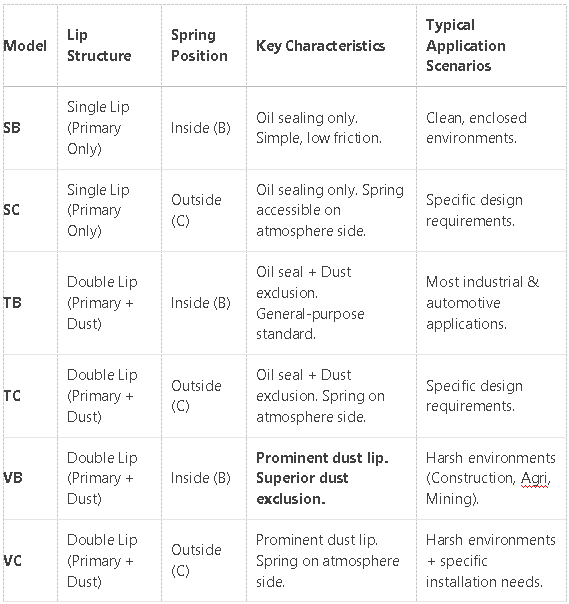Introduction: Tiny Component, Massive Responsibility
When your car’s engine drips oil or a factory hydraulic pump leaks, a crucial yet often unnoticed player is usually behind it – the oil seal. This ring-shaped component, often just a few centimeters in diameter, bears the mission of “zero leakage” in the mechanical kingdom. Today, we delve into the ingenious structure and common types of oil seals.
Part 1: The Precision Structure – Four-Layer Defense, Leak-Proof
Though small, an oil seal boasts an incredibly precise structure. A typical skeleton oil seal (the most common type) relies on the coordinated work of these core components:
-
The Steel Backbone: Metal Skeleton (Case/Housing)
-
Material & Form: Usually made from high-quality stamped steel plate, forming the seal’s “skeleton.”
-
Core Duty: Provides structural rigidity and strength. Ensures the seal maintains its shape under pressure or temperature changes and is securely fixed within the equipment housing.
-
Surface Treatment: Often plated (e.g., zinc) or phosphated to enhance rust resistance and ensure a tight fit within the housing bore.
-
-
The Driving Force: Garter Spring
-
Location & Form: Typically a fine coiled garter spring, snugly seated in a groove at the root of the primary sealing lip.
-
Core Duty: Provides continuous, uniform radial tension. This is the key to the seal’s function! The spring’s force compensates for natural lip wear, slight shaft eccentricity, or runout, ensuring the primary lip maintains constant contact with the rotating shaft surface, creating a stable sealing band. Think of it as an ever-tightening “elastic belt.”
-
-
The Leak-Proof Core: Primary Sealing Lip (Main Lip)
-
Material & Form: Made from high-performance elastomers (e.g., Nitrile Rubber NBR, Fluoroelastomer FKM, Acrylate Rubber ACM), shaped into a flexible lip with a sharp sealing edge.
-
Core Duty: This is the “key barrier,” making direct contact with the rotating shaft. Its primary function is sealing lubricating oil/grease, preventing outward leakage.
-
Secret Weapon: A unique edge design utilizes hydrodynamic principles during shaft rotation to form an ultra-thin oil film between the lip and shaft. This film is vital: it lubricates the contact surface, reducing friction heat and wear, while acting like a “micro-dam,” using surface tension to prevent bulk oil leakage. The lip often features tiny oil return helices (or a “pumping effect” design) that actively “pump” any escaping fluid back towards the sealed side.
-
-
The Dust Shield: Secondary Sealing Lip (Dust Lip/Auxiliary Lip)
-
Material & Form: Also made of elastomer, located on the outer side (atmosphere side) of the primary lip.
-
Core Duty: Acts as a “shield,” blocking external contaminants like dust, dirt, and moisture from entering the sealed cavity. Ingress of contaminants can pollute the lubricant, accelerate oil degradation, and act like “sandpaper,” accelerating wear on both the primary lip and shaft surface, leading to seal failure. The secondary lip significantly extends the overall seal life.
-
Contact & Lubrication: The secondary lip also has an interference fit with the shaft, but its contact pressure is generally lower than the primary lip. It typically doesn’t require oil film lubrication and is often designed to run dry.
-
Part 2: Decoding the Model Numbers: SB/TB/VB/SC/TC/VC Explained
Oil seal model numbers often follow standards like JIS (Japanese Industrial Standard), using letter combinations to denote structural features. Understanding these codes is key to selecting the right seal:
-
First Letter: Indicates Lip Count & Basic Type
-
S (Single Lip): Single Lip Type
-
Structure: Only the primary sealing lip (oil side).
-
Characteristics: Simplest structure, lowest friction.
-
Application: Suitable for clean, dust-free indoor environments where dust protection is not critical, e.g., inside well-enclosed gearboxes.
-
Common Models: SB, SC
-
-
T (Double Lip with Spring): Double Lip Type (with Spring)
-
Structure: Contains primary sealing lip (with spring) + secondary sealing lip (dust lip).
-
Characteristics: Provides dual function: sealing fluid + excluding dust. The most widely used, general-purpose standard seal type.
-
Common Models: TB, TC
-
-
V (Double Lip, Spring Exposed / Dust Lip Prominent): Double Lip Type with Prominent Dust Lip (with Spring)
-
Structure: Contains primary sealing lip (with spring) + secondary sealing lip (dust lip), where the dust lip significantly protrudes beyond the outer edge of the metal case.
-
Characteristics: The dust lip is larger and more prominent, offering superior dust exclusion capability. Its flexibility allows it to more effectively scrape contaminants off the shaft surface.
-
Application: Designed specifically for harsh, dirty environments with high dust, mud, or water exposure, e.g., construction machinery (excavators, loaders), agricultural machinery, mining equipment, wheel hubs.
-
Common Models: VB, VC
-
-
-
Second Letter: Indicates Spring Position (Relative to Metal Case)
-
B (Spring Inside / Bore Side): Spring Inside Type
-
Structure: The spring is encased inside the primary sealing lip, meaning it’s on the sealed medium (oil) side. The outer edge of the metal case is usually rubber-covered (except for exposed case designs).
-
Characteristics: This is the most common spring arrangement. The spring is protected by rubber from external media corrosion or jamming. During installation, the lip faces the oil side.
-
Common Models: SB, TB, VB
-
-
C (Spring Outside / Case Side): Spring Outside Type
-
Structure: The spring is located on the outer side (atmosphere side) of the primary sealing lip. The primary lip rubber usually fully encases the metal skeleton (fully molded).
-
Characteristics: The spring is exposed to the atmosphere. The main advantage is easier inspection and potential spring replacement (though rarely needed). Can be more convenient in some space-restricted housings or specific design requirements.
-
Crucial Note: Installation direction is critical – the lip still faces the oil side, with the spring on the atmosphere side.
-
Common Models: SC, TC, VC
-
-
Model Summary Table:

Part 3: Selecting the Right Oil Seal: Factors Beyond the Model
Knowing the model is the foundation, but choosing correctly requires considering:
-
Shaft Diameter & Housing Bore Size: Precise matching is essential.
-
Media Type: Lubricating oil, grease, hydraulic fluid, fuel, chemical solvent? Different elastomers (NBR, FKM, ACM, SIL, EPDM etc.) have different compatibility. E.g., FKM offers excellent heat/chemical resistance; NBR is cost-effective with good oil resistance.
-
Operating Temperature: Elastomers have specific operating ranges. Exceeding them causes hardening, softening, or permanent deformation.
-
Operating Pressure: Standard seals are for low pressure (<0.5 bar) or static applications. Higher pressures require special reinforced seals.
-
Shaft Speed: High speeds generate friction heat. Consider lip material, heat dissipation design, and lubrication.
-
Shaft Surface Condition: Hardness, roughness (Ra value), and runout directly impact seal performance and life. Shafts often need hardening (e.g., chrome plating) and controlled surface finish.
Part 4: Installation & Maintenance: Details Make the Difference
Even the best seal fails instantly if installed incorrectly:
-
Cleanliness: Ensure shaft surface, housing bore, and the seal itself are spotless. A single grain of sand can cause a leak.
-
Lubrication: Apply the lubricant to be sealed onto the lip and shaft surface before installation to prevent initial dry-running damage.
-
Direction: Absolutely confirm lip direction! The primary lip (side with the spring, usually) faces the fluid to be sealed. Installing backwards causes rapid failure. The dust lip (if present) faces the external environment.
-
Tools: Use dedicated installation tools or sleeves to press the seal squarely, evenly, and smoothly into the housing. Hammering or cocked installation damages lips or the case.
-
Protection: Avoid scratching the lip with sharp tools. Protect the spring from being dislodged or deformed.
-
Inspection: Regularly check for leaks, hardened/cracked rubber, or excessive lip wear. Early detection prevents major failures.
Conclusion: Small Seal, Big Wisdom
From the intricate four-layer structure to the model variations tackling diverse environments, oil seals embody remarkable ingenuity in materials science and mechanical design. Whether in car engines, factory pumps, or heavy machinery, oil seals work unseen to safeguard the cleanliness and efficiency of mechanical systems. Understanding their structure and types lays a solid foundation for reliable equipment operation.
Ever been frustrated by a failing oil seal? Share your experience or ask questions in the comments below!
#MechanicalEngineering #OilSeals #SealingTechnology #IndustrialKnowledge #AutoMaintenance
Post time: Jul-16-2025
